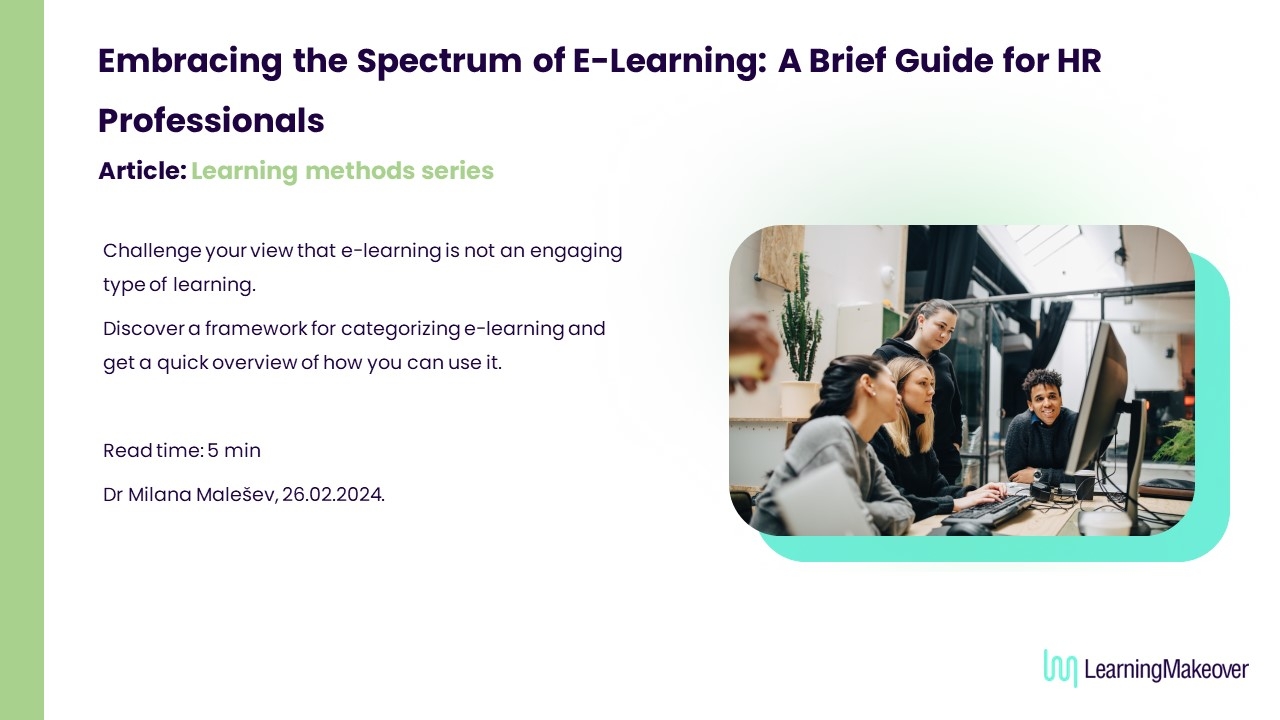Many of my HR colleagues express concerns that their employees are not fond of e-learning, associating it with tedious, obligatory online courses. This sentiment is understandable, yet it barely scratches what e-learning encompasses.
E-learning, or online learning, extends far beyond such confines, encompassing any learning method accessed via a computer or electronic device (Beevers, K. & Rea, A, 2016, p.160).
The realm of e-learning is vast, offering numerous forms that, I’m confident, both you and your employees have engaged with on your own, driven by personal initiative rather than employer mandates.
Here is one way we can categorize e-learning formats.
Informal e-learning
For example, common experiences with online tutorials are a testament to the power of informal e-learning. Faced with a computer or software issue, my first instinct is to search for a “How to” guide on Word, Excel, or PowerPoint. This immediate solution spares me the need to seek external help.
If I repeat the same action a couple of times, I`ll learn it. However, if I do it only occasionally, I don`t need to memorize it. The tutorial is always there. I can easily access it, and my cognitive resources can be better used elsewhere.
A new employee at a client’s company expressed a desire for procedural video tutorials, highlighting the efficiency of self-service learning over disrupting experienced colleagues’ workflows. Creating concise, well-structured tutorials can significantly streamline on-the-job learning and reduce frustration.
I have come across numerous experts on social media who inspire me with their content and recommendations. The comments on their posts also provide valuable insights and help me learn new things.
In this way social media can foster a dynamic learning environment that many, including your employees, benefit from without coercion. This self-directed learning is driven by the desire to overcome challenges or satisfy curiosity.
Large companies have internal social media and common interest groups. Often, these groups arise spontaneously and use very basic tools, such as WhatsApp. In one of my clients, new joiners regularly form a WhatsApp group where they reach out with questions and challenges and proactively share information and experience.
HR departments can nurture this learning culture by simply removing barriers and providing the necessary tools and platforms.
I find that I can learn a lot from reading well-written blogs, and I hope you do too, reading this text.
Experts within organizations can produce valuable content that captures lessons learned from both successful and unsuccessful projects. By sharing this knowledge across the company, teams can become more efficient and successful in dealing with similar projects and clients.
Some of my clients rely heavily on this practice, which allows new team members to quickly learn and stay relevant, even after those who originally captured the “lessons” have left the company.
To sum up, individuals engage in e-learning voluntarily because they possess a keen interest or a pressing need to acquire knowledge.
HR/L&D’s responsibility is to establish an environment that fosters the use of these e-learning methods.
For instance, you can organize events that facilitate networking opportunities where people can discover common interests and collaborate on them.
You can curate available resources for different interest groups, making them more accessible.
You can also identify obstacles to learning during onboarding or change initiatives and support experts in developing tutorials, checklists, or step-by-step guidelines.
In most cases of using informal e-learning forms, HR/L&D will act as curators and facilitators of knowledge sharing, rather than creators.
Formal e-learning
In contrast to the autonomous nature of informal learning, formal e-learning often involves pushing content towards employees. The challenge here is not in the value of the content (hopefully), but in its timing and presentation.
Therefore, if you only send an email introducing a new online course, you might be disappointed with the engagement.
To engage employees effectively, marketing the learning content creatively is essential. This could involve self-assessment tools, engaging trailers, positive testimonials, games like challenges and competitions, etc.
During the learning needs analysis phase, you can build support from management by involving them in the process. This will help them to become advocates of your solution.
Additionally, when designing your solution, consider incorporating elements that encourage learning such as interactive features, storytelling, and gamification. This will help to foster a positive and engaging learning experience.
E-learning can be highly effective as a supplement to more traditional approaches, and giving it more structure in this way can also raise the completion rates.
For instance, e-learning modules can introduce basic concepts prior to a workshop, maximizing the in-person time for discussion and practice. Post-workshop, they can reinforce learning, encourage continuous practice, and support behavior change.
While mandating certain e-learning courses may be necessary for compliance or onboarding, over-reliance on this approach can lead to disengagement. Moreover, people tend to find creative ways to cheat and avoid the messages that the course was meant to communicate.
The key is to balance mandatory training with engaging, voluntary learning opportunities.
I hope I have convinced you that e-learning is a very useful tool in our Learning and Development toolbox.
Whenever you are tempted to say that you don’t like e-learning or that your employees don’t like it, think twice and try to understand what didn’t work out and why.
Writing off e-learning, in general, is like dismissing videos as a medium because you saw a couple of bad TikTok or YouTube videos.
I will discuss in more detail the different use cases for e-learning and different ways to raise engagement in the following blog posts.

